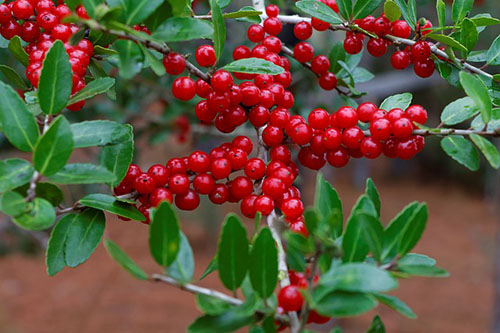Last updated on December 23rd, 2024 at 07:29 am
The Yaupon Holly Tree (Ilex vomitoria) is an evergreen shrub. Shining small leaves that stay green year-round with twiggy branches that are sharp and pointed. It grows to about 15 ft. tall and wide usually in about full maturity at about 8-10 years. The Yaupon Holly Tree will produce small white flowers in late spring,
Is it a tree or a bush? It is best to train it as a tree as it grows or leave it alone as it will become a large evergreen bush. The branches are strong and can easily poke through the skin if you are pruning the tree.
The one pictured below is about 3-4 years of age.
Where to plant the Yaupon Holly Tree?
It’s a great-looking small tree for the patio or out in the open. Small enough to plant in a courtyard or smaller type backyards. The berries will start with a light green color and will turn a bright red towards the end of the fall. These berries will last throughout the winter seasons.
They love the full hot sun and are considered a moderate watering tree but make sure to give them plenty of water during the first 2-3 years after initial planting. If you need to plant more than one it is best to space them out at least 10 ft. apart.
Yaupon Holly’s are insect and diseases resistant
The poor soil throughout the Southwest can result in the yellowing of leaves on the Yaupon holly. This can be remedied by incorporating iron into the soil. I recommend Growmore’s EDDHA Chelated iron, as it works wonders on any plant that appears chlorotic (yellowing of the leaves). Do not use a fertilizer with a high analysis of nitrogen.
Most birds are attracted to the bright red berries and will eat them for sustenance throughout the winter season. The female Yaupon holly will produce the berries.
The Yaupon Holly Tree produces bright red berries pictured below. These berries are not toxic to wildlife but can cause problems if ingested by humans.
According to Wildedible.com, The Stems and Leaves can be used to make tea. Read more below.
Yaupon holly tea has been used for ages by southeastern U.S. Indian tribes for both recreation and ceremony. Early white settlers knew the tea as “the black drink.” Ceremonially, it was sometimes made as a strong brew which intensified the tea’s emetic qualities inducing vomiting and purification, hence the Latin name vomitoria. Read more here.

The Weeping Holly Plant
There are other varieties that are similar such as the Weeping Yaupon Holly (Ilex vomitoria ‘Pendula’)
For something totally different plant the Weeping Holly as you can see by the photo over at Monrovia.com It has a sweeping downward look perfect for those looking for something different.
Berries on the Yaupon Holly Tree
In the world of Yaupon Holly, only the female plants are capable of producing the distinctive berries that many people associate with this species. To achieve this berry production, the female plants require pollination from male Yaupon Holly. However, identifying the differences between male and female Yaupon Holly plants can be an exceptionally challenging task, as they share many visual similarities that make distinction difficult.
Despite the challenges, there is a method to differentiate between the sexes by closely examining the flowers produced by the male Yaupon Holly. These male flowers bloom in early spring, offering a window of opportunity for those who are specifically looking to identify male plants. By observing the characteristics of these flowers in detail, one can gain insights into the plant’s gender despite the inherent challenges in visual identification. Read more over at – Melindamyers.com
The Dwarf Stokes Yaupon Holly
This Holly is much smaller about 2-3 ft. tall and 3 ft. wide. It is evergreen and can tolerate poor soil and drought conditions. Use it as a hedge plant for that formal look.
USDA Hardiness Zone: 7 – 10
More evergreen shrubs for the Southwest right here.

Greenhouse Manager, Master Gardener, and Webmaster.
If you have any questions or enjoyed this post, feel free to share your thoughts in the comments below.




